MECHANICAL WAVES for Class 11 PHYSICS
INTRODUCTION
Kya aapne kabhi pani me paththar fek ke khela hai? Kya aapne kabhi kisi dori ko jhatak ke dekha hai? Bs yahi to waves hai. Humare charo taraf waves hai jaise ki light ki waves ya phir sound ki waves. Sabhi waves ko hum mathematical terms me bhi describe kr sakte hai jisse different kinds of waves ki study me unhe correlate krne me easy hota hai. Jo dori ka eg. hai wo ek tarah se string hai isiliye usme jo oscillation aur propagation hota hai use hi hum string waves kahate hai. Is chapter me hum isi string waves me focus karenge. Ye string waves mechanical waves ke types me aata hai kyuki mechanical waves ka mtlb hai wo waves jinko travel (propagate) krne ke liye medium ki need hoti hai aur yaha pr dori medium hai.
Ab batao ki pani me paththar fekne se waves generate hona ya phir dori ko jhatakne se waves generate hone ka karan kya hai? Disturbance. Kyuki humne dori ya phir pani me force laga ke disturbance create kiya jiski wajah se wave originate hua. Kyon Ki yaha pani aur dori dono medium hai isliye ye mechanical wave hai. Medium me disturbance ke karan phle atom me motion hua jo next atom se takaraker use bhi motion me le ata hai means motion ko next atom me transmit kr deta hai. Jaise jaise wave pass hoti hai atom aaghe pichhe move krta hai.
Sound waves ek tarah se disturbance ka pattern hai jo ki energy ke movement ki wajah se hota hai through a medium ( jaise air, water aur koi bhi solid ya liquid matter) jo ki sound source se propagate hote hue aa rhi hai.
Source ek tarah ka object hai humara jo ki vibrations paida krta hai, such as ringing telephone or a person’s vocal chords.Toh jo vibrations paida ho rhe hai uss wajah se uss medium me jo particles hai unme disturbance paida hoga, and ek particle apne bagal waale particle me bhi disturbance create krdega and ye process chlti rahegi, toh baccho jo ye particle me disturbance hone ka jo pattern hai voh hai wave ke form me hota hai.
Baccho sound waves ko medium lgta hai propogate krne ke liye, otherwise ye propagate nhi hongi, isliye baccho sound waves vaccum me travel nhi krti hai.
Sound waves jo ki ek longitudnal waves hai voh reflect, refract, interfere and diffract but cannot be polarised kyunki keval transverse waves hi polarise ho sakti hai.
TYPES OF MECHANICAL WAVES
Baccho agr hum baat krein mechanical waves ki toh ye 2 type k hoti hai-
(i) Transverse waves
(ii) Longitudinal waves
TRANSVERSE WAVES
Baccho transverse wave voh wave hoti hai jisme particle ke motion ka direction and wave energy ke motion ka direction perpendicular hota hai.Mltb agr particle ke motion ka direction positive y-axis ki taraf hai toh wave ki motion ka direction ya toh negative x-axis hoga ya phir positive x-axis hoga ya phir negative z-axis hoga ya phir positive z-axis hoga, isi ko hum transverse wave bolte hai.
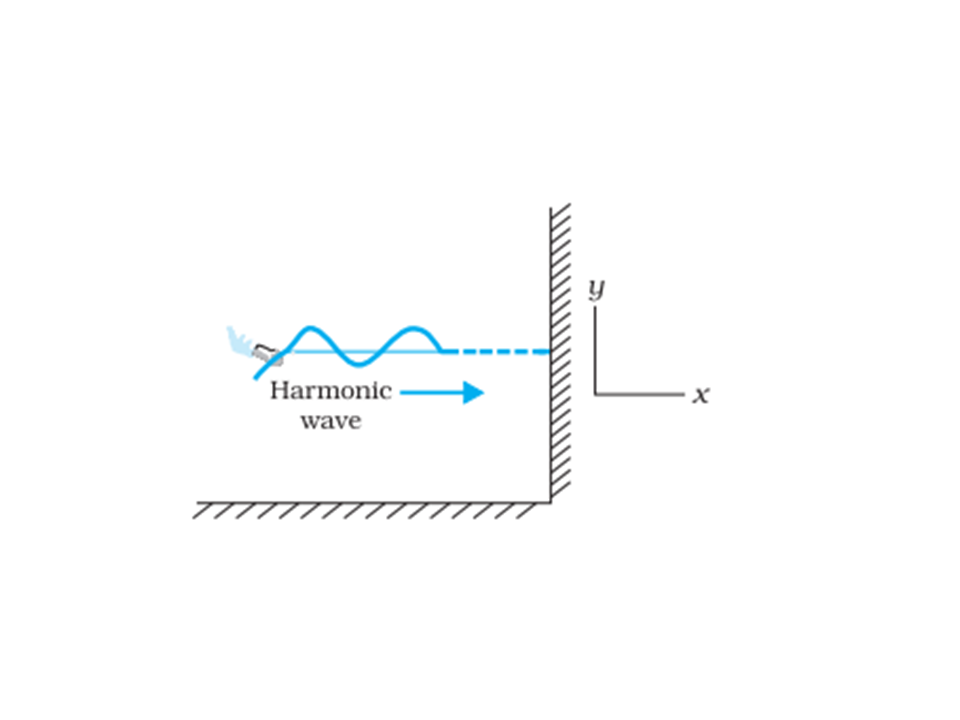
LONGITUDNAL WAVES
Baccho longitudnal wave voh wave hoti hai jisme particle ke motion ka direction and wave energy ke motion ka direction same hota hai hota hai.Mltb agr particle ke motion ka direction positive y-axis ki taraf hai toh wave ki motion ka direction ya toh negative y-axis hoga ya phir positive y-axis hoga.
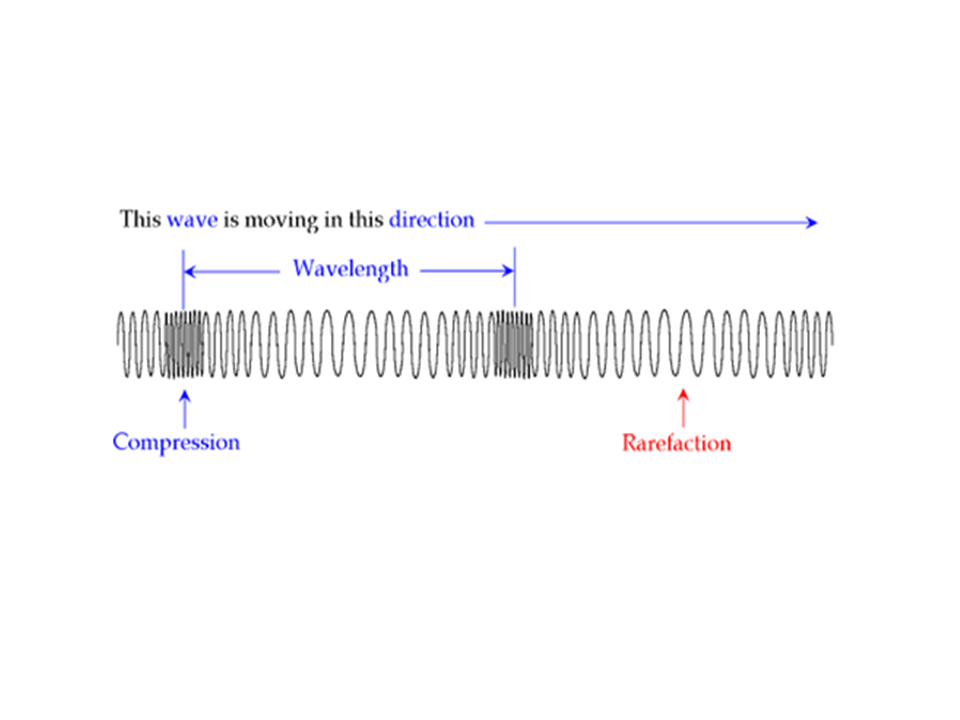
GENERAL EQUATION OF A WAVE
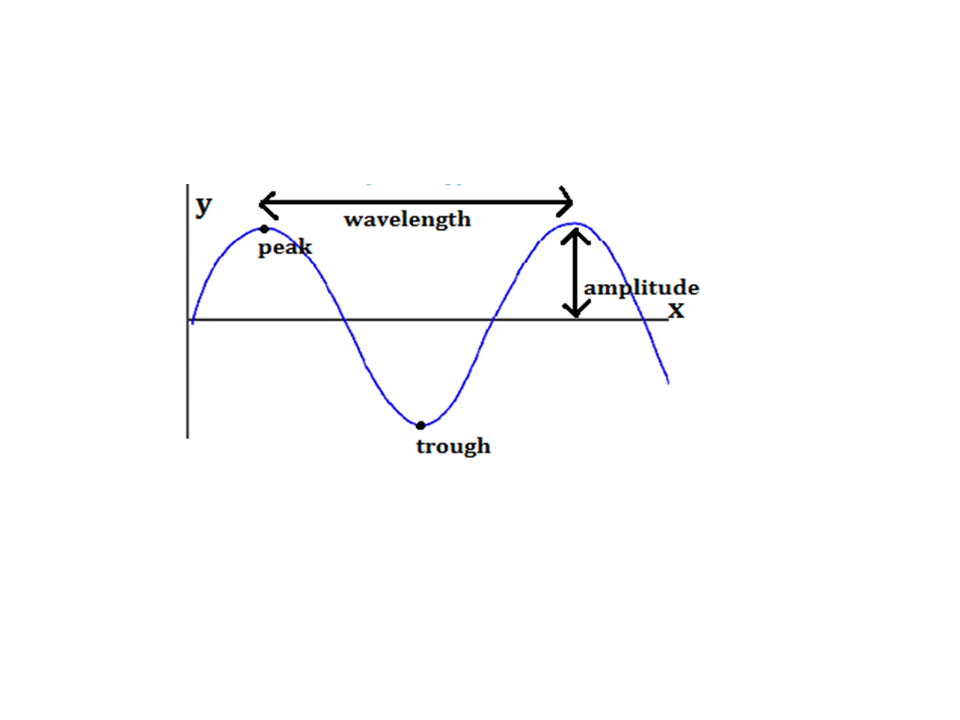
Baccho wave ki general equation likhna hai, mtlb hum displacement ki equaiton likhenge, yaha prr hum dekhe toh particle y direction me motion kr rha hai and voh motion kis kis quantity prr depend krega voh hme dekhna hai,
Therefore ,
y depends upons the position of particle on the x-axis, mtlb baccho yaha prr thousads of particles honge ,ab humse displacement ke baare me pucha jaa rha hai toh hume phle btana padega ki kis particle ke motion ke baare me baat ho rhi hai, isliye jis bhi particle ke motion ki baat krenge, uss particle ki position hm btana padegi.
y depends upon time t also, ab bachho hume position pta chl yi hai lekin particle toh SHM kr rha hai uss position in y direction, and time ke saath saath particle ki y direction me position bhi change ho rhi hai, toh baccho y humara time prr bhi depend karega.
Therefore the general equation of wave would be the function of x and t,
y=f(x,t) or we can write,
y=f(ax±bt)
And direction of wave baat krein toh baccho agr ax and bt same sign ke hai mtlb ya toh (ax+bt) ho ya phir (-ax-bt) ho toh wave negative x direction me travel karegi and agr ax and bt opposite sign ke hai mtlb ya toh (ax-bt) ho ya phir (-ax+bt) ho toh wave positive x direction me travel karegi.
And agr baccho yahin humse wave ki speed puche toh voh hoti hai,
Wave speed v=coefficient of tcoefficient of x and yaha prr hum ax and bt ka sign nhi dekhenge.
CONDITION FOR WAVE MOTION
Baccho hume ye toh pta chl gya ki wave ek x and t ka function hoga , lekin kya saari x and t ke functions wave honge?, nhi baccho esa nhi hoga, saare x and t ke function wave nhi ho sakte hai, toh ab baat aati hai ki kon konse x and t ke function wave motion krenge, toh uske liye uss function ko ek condition follow krni padegi, voh hai,∂2y∂t2=K∂2y∂x2 where K is constant which is !=0,
Iss equation me ∂2y∂t2 ka mtlb hai ki partial differentiation of y wrt time t, and same for ∂2y∂x2
And baccho y should be defines for all values of x and t, ye bhi jruri hai baccho, agr y defined nhi hai for the value of x and t, toh voh wave motion nhi hoga.
Toh baccho jab jab ye x and t ka function ye condition ko follow karega, voh voh wave motion ko follow krega,
DISPLACEMENT IN HARMONIC WAVE

Baccho ab hum baat krenge harmoic wave ki, toh iski displacement ki equation hogi,
y=Asin(wt±kx±ϕ),
Baccho upar diagrem me mene x direction ke along wave maani hai toh iski equation me likhunga,
y=Asin(wt−kx+ϕ)
WAVE LENGTH
Baccho wave length ki baat krein toh yeh hoti hai, distance travelled by wave in single time period T,Ab baccho wave ki velocity v hai positove x-axis ki taraf and after single time period T, wave jo distance travel kregi wahi wavelength hogi uski,
Therefore ,
v=λT,
λ=vT where λ is the wave length of wave.
ANGULAR FREQUENCY AND FREQUENCY
Baccho ye toh hum sabko pta hi hai ki frequency ko hum f se denote krte hai adn isko hum define krenge “no. of oscillations per second” ,And frequency f=1T where T is the time period.
Ab baccho hum angular frequency ki baat krein toh use hum ω se denote krte hai and iski SI unit hoti hai rads−1,
Therefore , ω=2πT ,
And relation between ω and f is-
ω=2πf
AMPLITUDE AND PHASE
Baccho humari wave ki equation thi jise hum analyse kar rhe hai voh hai, y=Asin(wt−kx+ϕ)Baccho isme jo A hai voh iss wave ka amplitude hota hai, means particle jab oscillate krega toh uska maximum displacement y direction ke along A hoga.
And baccho yaha prr jo ϕ hai voh phase hai wave ka, mtlb wave start hone se phle kisi x position prr or jis time motion start hua hai, uss time ye particle jis position prr hoga wahi uska phase hoga,
ANGULAR WAVE NUMBER (k)
y=Asin(wt−kx+ϕ)Baccho iss equation me k hota hai use hum angular wave number bolte hai or ya phir propagation constant bolte hai.
Isko humne upar bhi padha hua hai general eqn of wave me,
v=coefficient of tcoefficient of x
Or now we can write,
v=ωk
Hence , k=ωv
And now we know, ω=2πT and v=λT
After putting the values,
k=2πTλT
Therefore k=2πλ
THE SPEED OF A TRAVELLING WAVE
As we know,
Speed of wave , v=coefficient of tcoefficient of x
Therefore v=ωk
And ω=2πT and k=2πλ
Therefore, v=2πT2πλ
v=λT this is the speed of travelling wave.
SPEED OF A TRANSVERSE WAVE ON STRETCHED STRING
Baccho maan lijiye do strings hai aur dono strings alag alag bandhi hui hai tightly, ab baccho maana ki ek string ka mass dusri string se kam hai,Toh baccho jab humne wave bnai toh dekha ki jis string ka mass kam tha voh jldi travel kr gyi or jis string ka mass jyada tha voh late travel ki, that means,
Wave speed, v∝1mass of string
Ab baccho humne string ki tension ko dekha jaisa humne abhi mass ko dekha hai usi tarah, toh pta chla ki jis string me jitni jyada tension hogi, wave ki speed bhi utni hi jyada hogi.
Therefore , wave speed, v∝tension
Hence , humari string me speed ka formula jo aaya voh aaya,
v=√Tμ where T is the tension in the string
And μ is the mass per unit length of the string.
EXAMPLE 1
Given below are some examples of wave motion. State in each case, if the wave motion is transverse, longitudinal or a combination of both?
(i) Motion of a kink in a long coil spring produced by displacing one end of spring side ways.
(ii) Waves produed in a cylinder containing a liquid by moving its piston back and forth.
(iii) Waves produed by a motor boat sailing in water.
(iv) Light waves travelling from sun to earth.
(v) ultrasonic waves in air produced by a vibrating quartz crystal.
(a) Transverse and longitudinal
(b) Longitudinal
(c) Transverse and longitudinal
(d) Longitudinal
EXAMPLE 2
A wave travelling along a strong is described by
y(x,t)=0.005sin(80.0x−3.0t)
in which the numerical constants are in SI units (0.005m,80.0radm−1 and 3.0rads−1). Calculate (a) the amplitude. (b) the wavelength (c) the period and frequency of the wave. Also , calculate the displacement y of the wave at a distance x=30.0 cm and time t=20 s?
On comparing this displacement equation with Eq. (15.2),
y(x,t)=asin(kx−ωt).
we find
(a) the amplitude of the wave is 0.005 m = 5 mm.
(b) the angular wave number k and angular frequency ω are
l=80.0m−1 and ω=3.0s−1
We, then, related the wavelength λ to k through Eq. (15.6),
λ=2π/k
=2π80.0m−1
=7.85 cm
(c) Now, we related T to ω by the relation T=2π/ω
=2π3.0s−1
=2.09s
and frequency, v=1/T=0.48 Hz
The displacement y at x=30.0 cm and time t=20 s is given by
y=(0.005m)sin(80×0.3−3.0×20)
=(0.005m)sin(−36+12π)
=(0.005m)sin(1.699)
=(0.005m)sin(97∘)≅5mm
EXAMPLE 3
A steel wire 0.72 m long has a mass of 5.0×10−3 kg . If the wire is under a tension of 60 N, what is the speed of transverse waves on the wire ?
Mass per unit length of the wire,
μ=5.0×10−3kg0.72m
=6.9×10−3kgm−1
Tension, T=60 N
The speed of wave on the wire is given by
v=√Tμ=√60N6.9×10−3kgm−1=93ms−1
POWER TRANSMITTED ALONG THE STRING BY A SINE WAVE
Baccho jaisa ki hume ki pta hai ki kinetic energy per unit length and potential energy per unit length same hoti hai string wave me or voh hoti hai,
dKdx=12μA2ω2cos2(ωt−kx), this is the kinetic energy per unit length,
And dPdx=12μA2ω2cos2(ωt−kx), this is the potential energy per unit length.
Therefore total energy per unit length in string wave is-
dEdx=12μA2ω2cos2(ωt−kx)+12μA2ω2cos2(ωt−kx)
Therefore ,
dEdx=μA2ω2cos2(ωt−kx), this is the total energy per unit length of string.
Ab baccho baat krein power transmitted, toh voh hoti hai energy per unit time,
Power P=dEdt, lekin baccho hume toh (dE)/dx pta hai, toh hum kya krenge dx ka multiply and divide krdenge,
Therefore,
P=dEdx×dxdt
Hence, P=μA2ω2cos2(ωt−kx)×v where dxdt=v
Ab baccho ye jo power aayi hai ye instantaneous power hai kisi time t ki,
Pinst=μA2ω2cos2(ωt−kx)×v
Hume ek wave ki poori 1 cycle ki power chahiye toh hum iska average nikalenge,
Therefore ,
Pavg=μA2ω22, this is the average power in 1 cycle.
THE PRINCIPLE OF SUPERPOSITION
Baccho do aur do se jyada wave same medium me travel kar sakti hai without affecting the motion of one another.
Agr kuch waves ek hi medium me propagate krti hai simultaneously, toh jo resultant displacement hoga kisi bhi particle ka uss medium me, voh equal hoga vector sum of each wave jo bhi uss medium me propagate kr rhe hai.
Iski definition likhenge,
“The resultant displacement of a particle at any point of the medium, at any instant of time is the vector sum of the displacements caused to the particle by the individual waves.”
Agr →y1, →y2, →y3............displacement hai particle ka by each wave, toh jo resultant displacement hoga ,
→y=→y1+→y2+→y3+.........
Aur baccho har type ki wave me superposition ka principle lgta hai.
INTERFERENCE OF WAVES
Baccho aisi do waves jinki frequency same hai and lagbhag same amplitude bhi hai and voh dono waves same direction me propagate kr rhi hai and inn dono wave ka state of polarisation usi medium me bhi same hoga, toh phir baccho inn dono ki intensity different hogi.
Kisi kisi jagah prr intetnsity jyada hogi or kisi kisi jagah prr intensity 0 bhi ho sakti hai.
Let the angular frequency be ω and angular wave number be k,
Consider two waves, y1=A1sin(ωt−kx) and y2=A2sin(ωt−kx+ϕ)
Now by principle of superposition,
y=y1+y2
Therefore , y=Asin(ωt−kx+δ)
Where, A=√A21+A22+2A1A2cosϕ
And tanδ=A2sinϕA1+A2cosϕ
And we know that, intensity I∝A2,
Hence,
I=I1+I2+2√I1I2cosϕ
CONSTRUCTIVE INTERFERENCE (MAXIMUM INTENSITY)
Baccho intensity maximum tab hogi jab cosϕ ki value maximum hogi and cosine ki maximum value 1 hoti hai,Therefore at ϕ=0∘ cosϕ=1,
Hence intensity will become,
Imax=I1+I2+2√I1I2cos0∘
Imax=I1+I2+2√I1I2
Hence, Imax=(√I1+√I2)2
And Amax=A1+A2
DESTRUCTIVE INTERFERENCE (MINIMUM INTENSITY)
Baccho intensity minimum tab hogi jab cosϕki value minimum hogi and cosine ki minimum value −1 hoti hai,Therefore at ϕ=180∘ cosϕ=−1,
Hence intensity will become,
Imin=I1+I2+2√I1I2cos180∘
Imin=I1+I2−2√I1I2
Hence, Imin=(√I1−√I2)2
And Amin=A1−A2
REFLECTION OF WAVES
REFLECTION FROM RIGID END

Baccho aapko dikh rha hoga ki ek right end humara wall se connected hai jo ki rigid end hai and left end se hum ek pulse paas krenge, jaise hi pulse right end pr pahuchegi, vese hi pulse ek force lgaegi rigid end prr and same equal and opposite force rigid end lgaega pulse prr.
Ab jaisa ki hume pta hai ki right end fixed hai wall prr, toh jo force puse lgaegi rigid end prr uss wajah se wave ka motion hoga and jo force rigid end lgaega pulse ke upar, uss wajah se pulse vaps reflect ho jaegi or voh bhi inverted, ab baccho baat aati hai ki invert kyu hui ring, toh baccho jaisa ki abhi aapne dekha ki pusle bhi ek force lga rhi hai and rigid end bhi force lga rhi hai, same usi tarah pulse rigid end o upar ki taraf move krana chahti hai, toh baccho rigid end as a reaction pulse ko neeche bhejna chahega, ab baccho pulse rigid end ko upar nhi shift kr pata hai kyunki voh end fixed hai but as a reaction force jab rigid end pulse prr lgata hai toh pulse neeche ki taraf move kr jaati hai, isliye baacho ye inverted hoti hai.
Therefore,
Equation of wave propagating in +ve x-axis,
Incident wave, y1=Asin(ωt−kx)
Reflected wave, y2=Asin(ωt+kx+π) or y2=−Asin(ωt+kx)
REFLECTION FROM FREE END
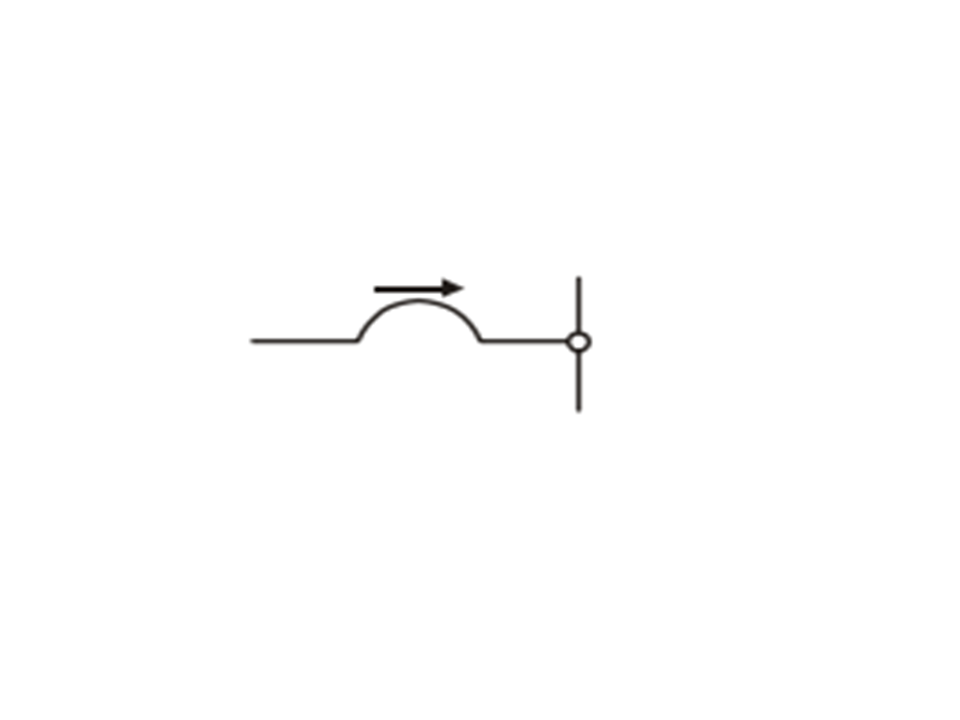
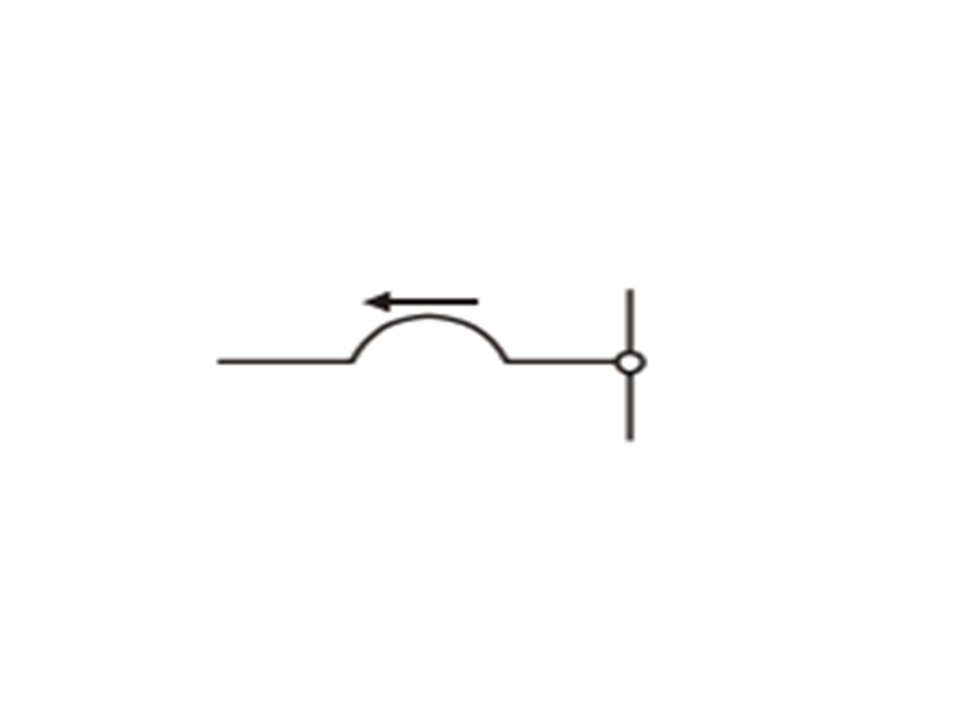
Baccho is case me hum right end ko ek light frictionless ring se attach krdete hai jo ki vertical rod prr freely move kar sakta hai. Ab humne ek pulse transfer ki from left end to right end of the string,
Toh iss case me humara right end free to move hai, iss condition me baccho humari pulse vaps aajaegi without inversion,
Therefore,
Equation of wave propagating in +ve x-axis,
Incident wave, y1=Asin(ωt−kx)
Reflected wave, y2=Asin(ωt+kx)
STANDING OR STATIONARY WAVES
Baccho jab do waves jinka amplitude same ho, unki frequencies bhi same ho, aur voh dono waves opposite direction me travel kar rhi ho, toh inn dono waves ko superimpose krne prr jo wave milti hai use hum standing wavesor stationary waves bolte hai.
Iski defintion hogi,
“The wave propagating in such a medium will be reflected at the boundary and produce a wave of the same kind travelling in the opposite direction. The superposition of the two waves will give rise to a stationary wave. Formation of stationary wave is possible only and only in bounded medium.”.
FROM RIGID END
Baccho hume pta hai ki progressive wave in positive x-direction is given by-y1=Asin(ωt−kx)
And rigid end se reflection ke baad,
y2=Asin(ωt+kx+π) or y2=−Asin(ωt+kx)
Now by the principle of superposition,
ynet=y1+y2
ynet=Asin(ωt−kx)−Asin(ωt+kx)
Therefore ,
ynet=−2Asinkxcosωt, this is the equation of standing wave from the rigid end or fixed end.
Iska amplitude hoga 2Asinkx
Nodes banenge at x=0,λ2,λ,3λ2..........
And antinodes banenge at x=λ4,3λ4.........
FROM FREE END
Baccho hume pta hai ki progressive wave in positive x-direction is given by-y1=Asin(ωt−kx)
And free end se reflection ke baad,
y2=Asin(ωt+kx)
Now by the principle of superposition,
ynet=y1+y2
ynet=Asin(ωt−kx)+Asin(ωt+kx)
Therefore ,
ynet=2Acoskxsinωt, this is the equation of standing wave from the free end. Iska amplitude hoga 2Acoskx
Antiodes banenge at x=0,λ2,λ,3λ2..........
And nodes banenge at x=λ4,3λ4.........
EXAMPLE 4
The equation of a transverse wave propagating in a string is given by
y=0.02sin(x+30t)
where, xandy are in second.
If linear density of the string is 1.3×10−4kg/m, then the tension in the string is
v=ωk=√Tμ
∴T=μ(ωk)2=(1.3×10−4)(301)2
=0.12N
EXAMPLE 5
A wave moves with speed 300m/s on a wire which is under a tension of 500N. Find how much tension must be changed to increase the speed to 312m/s?
Speed of a transverse wave on a wire is,
v=√Tμ
Differrntiating with respect to tension, we have
dvdT=(12√μT)
Dividing Eq.(ii) by Eq.(i), we have
dvv=12dTT or dT=(2T)dvv
Substituting the proper values, we have
dT=(2)(500)(312−300)300
=40N
i.e. tension should be increased by 40N.
TRANSMISSION OF WAVES
Baccho abhi tak humne reflection of wave padha, ab hum baat krenge transmission of wave, jese ki baacho reflection me wave jis medium se incident hoti hai, usi medium voh refect hojati hai toh uss wave ki speed same rehti hai, lekin transmission ke case me medium change hota hai,
Isme baccho medium to medium transmission hota hai, means rarer to denser ya phir denser to rarer.
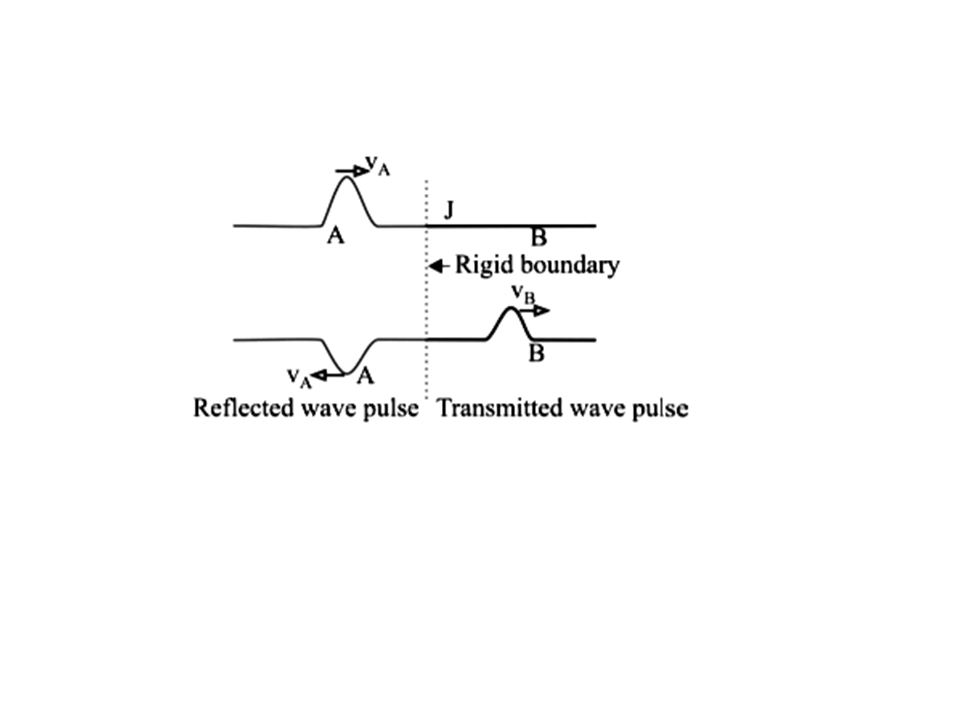
Ab baccho jaisa ki aap deh paa rhe hai diagram me ki wave ko humne rarer medium se denser medium me bheja hai, yaha denser medium mtlb hai baccho ki string ka mass jyada hai,
Ab baccho jaisa ki humne padh liya hai ki velocity in string hota hai,
v=√Tμ
And μ yaha hota hai mass of string per unit length, toh baccho rarer medium ki string ka mass kam hai as compare to denser medium, toh baccho jitna bda mass utna bda μ and jitna bda μ utna bdi uski velocity.
Isliye baccho transmission me velocity change hoti hai,
Agr wave denser to rarer medium me jaegi toh velocity increase kregi and agr wave rarer to denser medium me jaegi toh velocity decrease kregi.
Toh jaisa ki aap diagram me dekh paa rhe hoge ki ye case rarer to denser medium ka hai, toh incident wave ka kuch part reflect hoke vaps aaega and kuch part transmit krega, reflected part invert hoke vaps aajaega, and transmitted part ki velocity kam ho jaegi and voh aage medium me travel kr jaegi.
SONOMETER
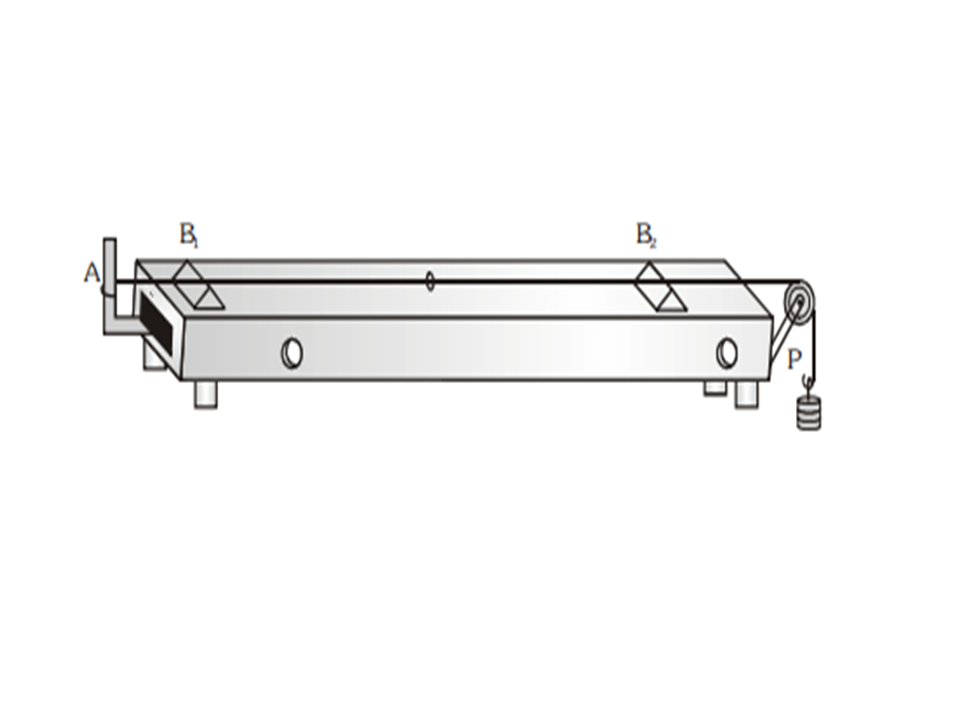
Sonometer consists of a hollow rectangular box of light wood. Isme jo experimental wire hota hai, uske hum ek end ko box ke end se baandh dete hai, phir uss wire ko ek frictionless pulley P ke upar se nikaal kr box ke dusre end tk le jaate hai and uss wire ke end ko hum tension T se stretch krte hai.
Iss box ka kaam ye hota hai ki jab hum iss wire ko vibrate krte hai toh jo sound produce hota hai vibration ki wajah se, uss sound ki loudness ko increase krne ke liye hum box ka use krte hai.
Maan lijiye wire ki length l hai, toh jo frequency of vibration hogi,
f=12l√Tm
Ab humne string me tension ko test krne ke liye ek paper ka chhota sa tuda uske upar rakh diya, aur tuning fork se uss wire ko vibration diya, maan lijiye voh jab humne tuning fork se vibration diya wire ko, toh dono ke paas same frequency aai, toh jo paper hoga voh neeche gir jaega.
EXAMPLE 6
A particle of mass 50g participates in two simple harmonic oscillations simultaneously as given by x1=10(cm)cos[80π(s−1)t] and x2=5(cm)sin[(80π(s−1)t+π/6]. The amplitude of particle's oscillations is given by 'A'. Find the value of A2(in cm2).
A=√A21+A22+2A1A2cosϕ=√102+52+2×5×10×12=√175⇒A2=175.
EXAMPLE 7
A progressive wave on a string having linear mass density ρ is represented by y=Asin(2πλx−ωt) where y is in mm. Find the total energy (in μJ) passing through origin from t=0 to t=π2ω.
[Take : ρ=3×10−2kg/m,A=1mm,ω=100rad..sec,λ=16cm].
Total energy 12ρA2ω2×λ4.
TYPES OF SOUND WAVES
INFRASONIC WAVES
Voh sound waves jinki frequency 0 se 20 Hz ke beech me lie kregi, use hum infrasonic waves bolte hai.AUDIABLE WAVES
Voh sound waves jinki frequency 20 se 20000 Hz ke beech me lie kregi, use hum audiable waves bolte hai.ULTRASONIC WAVES
Voh sound waves jinki frequency greater than 20000 Hz hoti hai, use hum ultrasonic waves bolte hai.Agr vs, vl and vg are the speed of sound waves in solid, liquid and gases then,
vs>vl>vg
VELOCITY OF SOUND (LONGITUDNAL) WAVES
Sound waves ki jo velocity hoti hai voh medium ki elasticity and medium ki density prr depend krta hai.
Therefore jo velocity hoti hai sound waves ki voh hoti hai,
v=√Eρ
Where E=coefficient of elasticity of the medium,
ρ=density of medium
NEWTON’S FORMULA
According to newton, kisi bhi gas me longitudnal waves ka propagation ek isothermal process hoti hai.
Therefore ,
Velocity of sound (longitudnal) waves in a gas should be
v=√ETρ=√pρ
Here ET= isothermal coefficient of volume elasticity and it is equal to the pressure of the gas.
LAPLACE’S CORRECTION
Baccho laplace correction me esa kuch nhi hai bss inhone bss newtons ko hi thoda correct kiya, inhone bola ki jo longitudnal waves voh ek adiabatic process hoti hai.
Toh inke hisaab se velocity of sound wave will become,
v=√ESρ=√γpρ
Where ES= adiabatic coefficient of volume elasticity and it is equal to γp.
FACTORS AFFECTING VELOCITY OF SOUND WAVE
EFFECT OF PRESSURE
Jaisa ki humne abhi upar dekha velocity of sound wave jo ki newton ne btatya, v=√pρ , that meansv∝√p and we know that v∝√RTM, therefore pρ humesha constant rahega kyunki temperature constant hai (isothermal process).
Iska mtlb hai ki sound wave ki velocity prr pressure ka koi effect nhi hota hai.
EFFECT OF TEMPERATURE
Agr laplace se baat ki jaye toh unhone correction kiya tha ki velocity of sound wave, v=√γpρ that meansv∝√p or v∝√RTM
Hence, v∝√T
Therefore v1v2=√T1T2
EFFECT OF DENSITY
Velocity of sound wave is inversely proportional to square root of density,v∝1√ρ
Therefore , v1v2=√ρ2ρ1
VIBRATION IN ORGAN PIPES
Jab do longitudinal waves with same frequency and same amplitude ek medium me travel krti hai voh bhi opposite directions me toh by the principle of superposition, standing waves produce hoti hai.
Inn waves ko hum air column me produce krte hai jo ki ek cylindrical tube hota hai with uniform diameter, esi sound producing tubes ko hum organ pipe bolte hai.
VIBRATION OF AIR COLUMN IN CLOSED ORGAN PIPE
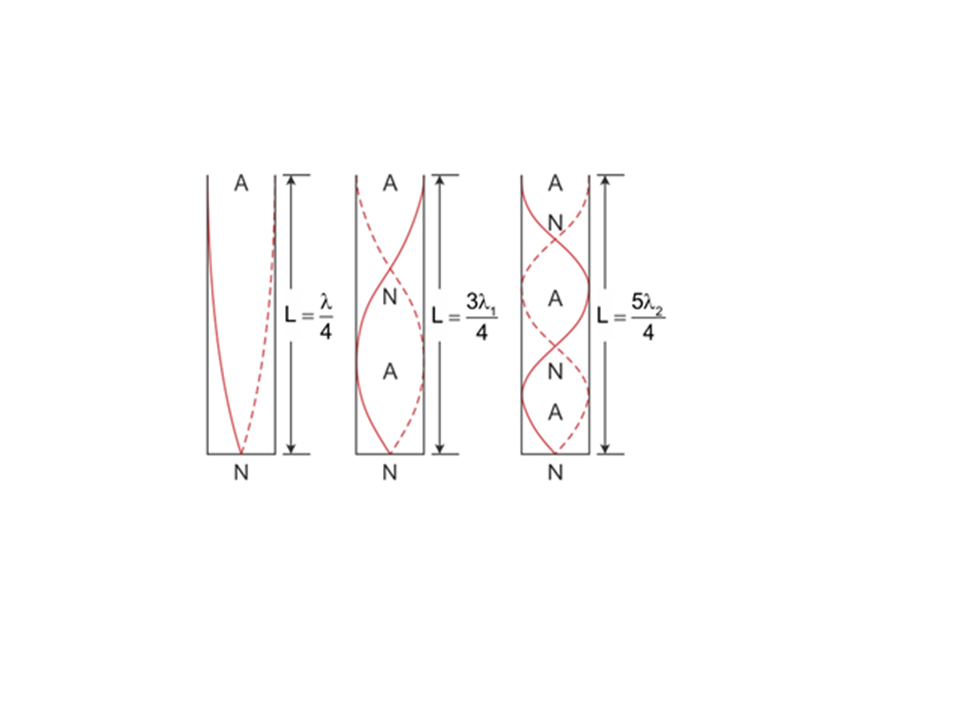
Aisa tube jiska ek end closed ho aur dusra end open ho, uske hum closed organ pipe bolte hai. Ab baccho jab hum open end se air ko blow krwaenge iss organ pipe me toh voh air travel kregi towards the closed end and closed end se reflect hoke vaps open end ki taraf travel kregi and again open end se closed end ke liye reflect ho jaegi. Toh do longitudnal waves opposite directions me travel kr rhi hai toh superposition hoga, and hume standing waves milengi. Closed end prr node banega kyunki waha ke particles ko freedom nhi hai vibrate krne ki and open end prr antinode banega kyunki open end ke particles ke aas sabse jyada freedom hogi vibrate krne ki.
Hence jab hum air blow krte hai closed organ pipe me, toh column vibrate krta hai and free end prr antinode bnata hai and closed end prr node bnata hai.
If L is the length of pipe, λ be the wavelength and v be the velocity of sound in organ pipe then,
Toh jaisa ki aap upar diagram me dekh paa rhe hoge, usme baar ka demo dikhaya hai,
Case 1 L=λ4 , therefore λ=4L
And frequency hogi, n1=velocityλ
n1=vλ
Hence n1=v4L , baccho n1 humari frequency hai or ise hum fundamental frequency bolte hai.
Case 2 L=3λ4 , therefore λ=4L3
And frequency hogi, n2=vλ
n2=3v4L , ise hum bolte hai First overtone/ 3rd harmonic
Case 3 L=5λ4 , therefore λ=4L5
And frequency hogi, n3=vλ
n2=5v4L , ise hum bolte hai Second overtone/ 5th harmonic
Hence jab closed organ pipe mth overtime me vibrate krta hai toh,
L=(2m+1)λ4
So, λ=4L2m+1
And n=(2m+1)v4L
VIBRATION OF AIR COLUMN IN OPEN ORGAN PIPE
Aisa tube jo dono end se open ho use hum open organ pipe bolte hai.Jab hum air blow krate hai pipe me kisi ek end se toh ek open end se air travel krti hai toward other open end and then vaps air travel kregi towards first open end and ab inn dono longitudinal waves ka superposition krne prr hume standing waves milengi.
Ab jaisa ki hume pta hai ki dono hi end open hai and open ends rr antinodes bante hai, toh iss case me dono ends prr antinodes banega and beech me node banega.
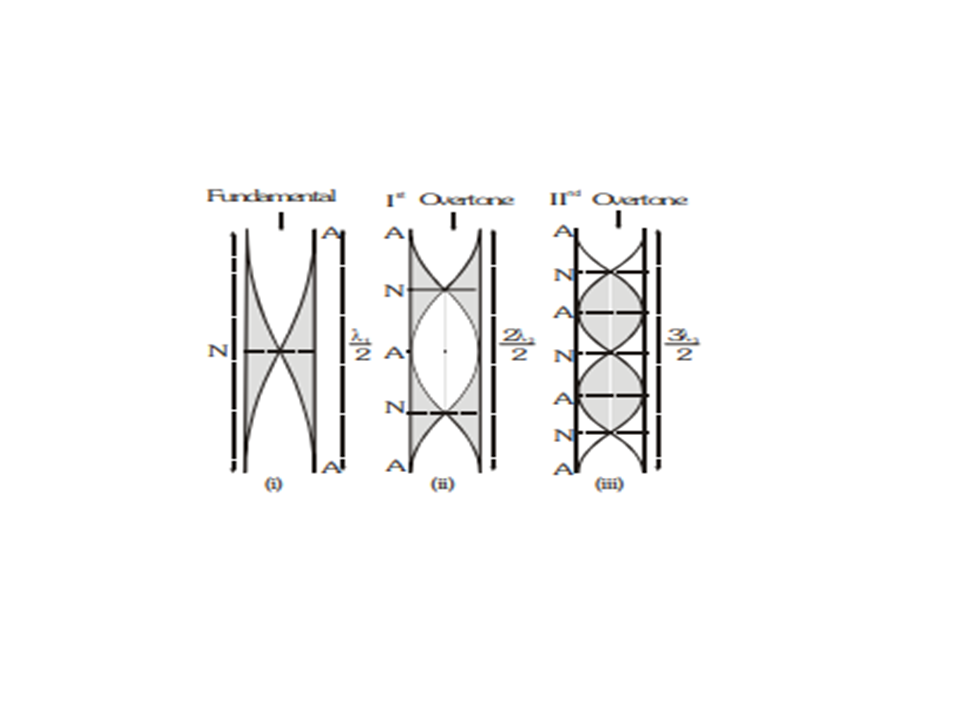
If L is the length of pipe, λ be the wavelength and v be the velocity of sound in organ pipe then,
Toh jaisa ki aap upar diagram me dekh paa rhe hoge, usme baar ka demo dikhaya hai, Case 1 L=λ2 , therefore λ=2L
And frequency hogi, n1=velocityλ
n1=vλ
Hence n1=v2L , baccho n1 humari frequency hai or ise hum fundamental frequency bolte hai.
Case 2 L=2λ2 , therefore λ=2L2
And frequency hogi, n2=vλ
n2=2v2L , ise hum bolte hai First overtone
Case 3 L=3λ2 , therefore λ=2L3
And frequency hogi, n3=vλ
n2=3v2L , ise hum bolte hai Second overtone
Hence jab closed organ pipe mth overtime me vibrate krta hai toh,
L=(m+1)λ2
So, λ=2Lm+1
And n=(m+1)v2L
BEATS
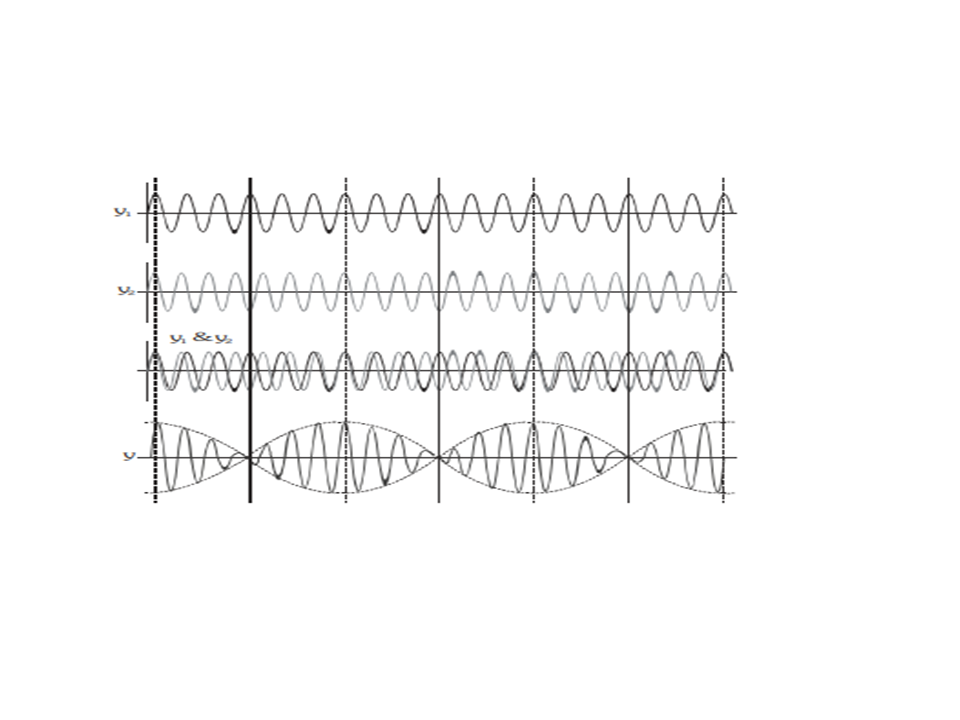
Jab do sound waves jinke amplitude same hai and voh same direction me travel kr rhi hai lekin unki frequencies me thoda sa diffrerence hai, jab inn wave ka superimposition hota hai toh milta hai ki intensity periodically vary kr rhi hai with time, isi effect ko hm beats bolte hai.
Jaisa ki aap diagram me dekh sakte hai, humne do sound waves li, then unka superimpostiion dekha, and them resultant wave aai.
Maan lijiye dono waves ki frequencies f1 and f2 or voh kisi point prr meet kr rhi hai in space and inka jo corresponding period hai voh T1 and T2 hai.
Agr dono waves kisi phase me hai at t=0 then after one full cycle voh phirse same phase me honge or esa hoga after t=T jo ki beats a period hai.
Let n be the number of cycles of the first wave in time T, then the number of cycles of the second wave in the same time is (n–1).
Hence T=nT1=(n−1)T2
Now after eliminating n, we will get,
T=T1T2T2−T1
T=11T1−1T2
Or
T=1f1−1f2
And the reciprocal of the beat period is the beat frequency, f=1T=f1−f2
ECHO
Jaisa baccho aapne deha hoga ki jab hum ek khaali room me kuch bolte hai toh aawaz gunjti hai lekin ek room jisme samaan rakha hua hai usme aawaz nhi gunjti hai, aawaz isliye gunjti hai khaali room me baccho kyunki sound waves ka reflection hota hai room ki walls se aur voh bhi multiple times aur isi phenomena ko hum echo bolte hai.
Maan lijiye reflector aur source ke beech ka distance d hai, toh baccho wave kitna travel kregi? Voh 2d distance travel kregi kyunki wave reflector se reflect hoke vaps source tk aaegi tabhi toh hume aawaz sunai degi vaps,
Toh maan lijiye agr v=velocity of sound and t=time of echo,
Therefore, v=2dt or d=vt2
Ab baccho agr hum ane ears ki baat krein toh jo ordinary sound ka effect humare ears me 110 seconds ke liye hota hai,
Toh minimum distance of the reflector is d=vt2,
d=(3302)(110)=16.5m
DOPPLER’S EFFECT FOR SOUND WAVES
Baccho jab humara sound ka source, obsever adn medium jab ek relative motion me ho ek dusre ke saath, tab jo frequecy me changes aate hai use hum doppler’s effect bolte hai.
Ab baccho hum isko derive krne ke liye kuch assumptions maanenge,
(i) The velocity of the source, the observer and the medium are along the line joining the positions of the source and the observer.
(ii) The velocity of the source and the observer is less than velocity of sound.
CASE I : Source moving, observer stationary
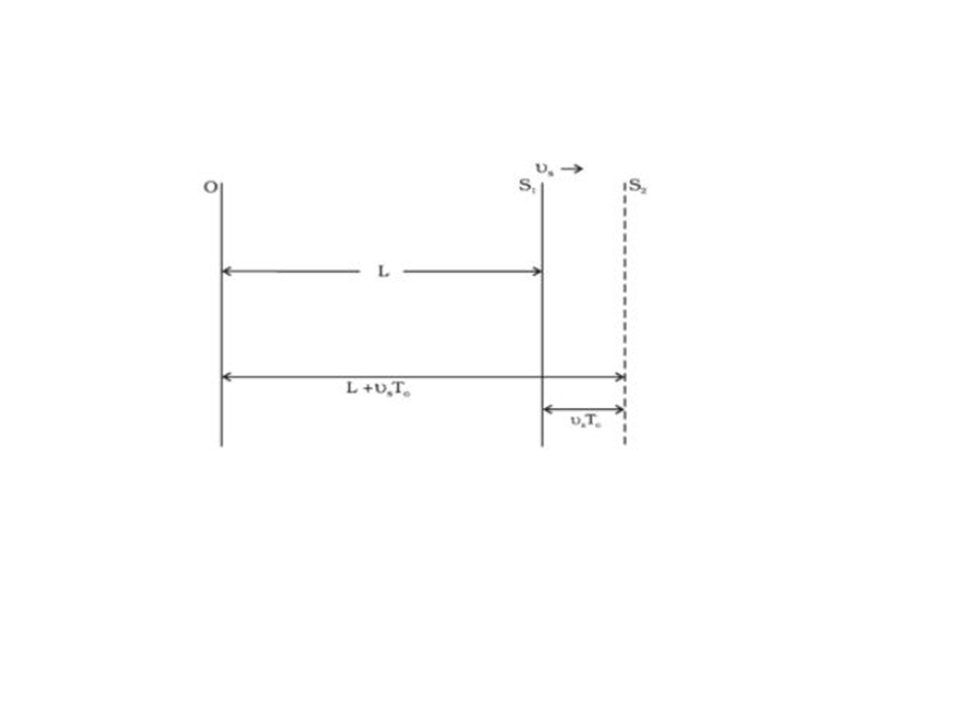
Jaisa ki aapko dikh rha hoga diagram me ki ek observer hai O prr and moving soruce ki initially position jab voh rest prr hai voh hai S1 and move krne ke baad uski position hai S2 and observer and S1 ki distance hai L.
And maan lijiye wave ki speed v hai jiski angular frequecy ω hai and time period T0 hai.
At t=0 humara source S1 prr hai, toh t1=Lv time me wave observer ke pass pahuch jaegi, now source ki velocity vs hai and time t=T0 ke baad voh vsT0 distance cover krlega. Toh jo observer se distance hoga after moving the source voh hoga (L+vsT0). Ab S2 position prr dusra crest emit hoga, toh vh observer ke pass time t2=T0+L+vsT0v.
And agr hum nT0 time ki baat krein toh jo source emit krega (n+1)th crest hogi, Toh observer ke pass time tn+1=nT0+L+nvsT0v me pahuchega.
Iska mtlb hai ki time period [nT0+L+nvsT0v−Lv] me jo observer hai use nth crest milegi and voh time period note krega,
T=[nT0+L+nvsT0v−Lv]/n
T=T0+vsT0v
T=T0(1+vsv)
Ab hum isko frequency ke terms me bhi likh sakte hai,
ν=ν0(1+vsv)−1
Ab jaisa ki hume pta hai ki vs bhut chhota hai as compare to wave velocity, toh hum iska binomial expansion krdenge and higher powers ko neglect krdenge toh jo expression aaega voh hoga,
ν=ν0(1−vsv) , this is the frequency when source is going away from the observer,
And if we replace the sign of vs to −vs, then it will become
ν=ν0(1+vsv), this is the frequency when source is approaching the observer.
CASE II : Observer moving, source stationary
Ab iss case me baccho observer move kr rha hai source ki taraf with velocity v0, humare saare sign convections and notations same rahenge jo humne upar maana hai, toh iss case me observer approach kr rha hai source ko and uss time velocity hogi v0+v, toh baccho jo time interval hoga first and (n+1)th crest me voh hoga,tn+1−t1=nT0−nv0T0v0+v,
Toh observer time period note krega wave ka voh hoga,
=T0(1−v0v0+v)
=T0(1+v0v)−1
And frequency hogi,
ν=ν0(1+v0v)
CASE III : Both Source and Observer Moving
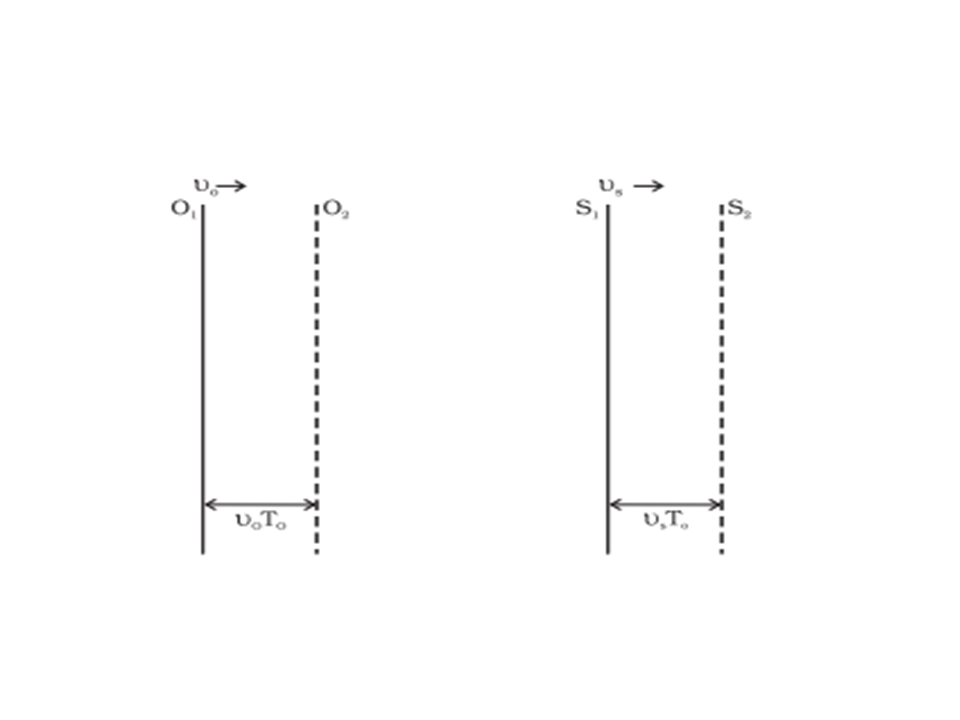
Baccho iss case me observer and source dono move kr rhe hai with velocity v0 and vw, initially at t=0, huamra observer O1 prr hai and source S1 prr hai and source and observe ke beech ki distance L hai. Toh ab hum observer se baat krenge toh use wave ki speed v+v0 dikhegi and time t1 aaega t1=Lv+v0, now after time t=T0, dono observer and source apni new position prr pahuch jaenge O2 and S2, toh jo new distance observer and source ke beech me hoga voh hoga L+(vs−v0)T0.
Ab source S2 prr second crest emit krega toh voh observer ke pass time,
t2=T0+[L+(vs−v0)T0]v+v0
At time nT0 the source emits its (n+1)th crest and this reaches the observer at time tn+1=nT0+[L+n(vs−v0)T0]v+v0
Hence , time interval tn+1−t1 that means,
nT0+[L+n(vs−v0)T0]v+v0−Lv+v0
Observer count krta hai n crests and time period record krta hai T=T0(1+vs−v0v+v0)
Or T=T0(v+vsv+v0)
Toh jo frequency observe hogi observer ke end prr voh hogi,
ν=ν0(v+v0v+vs)
EXAMPLE 8
Estimate the speed of sound in air at standard temperature and pressure. The mass of 1 mole of air is 29.0×10−3kg, λ for air.
We know that 1 mole of any gas occupies 22.4 litres at STP. Therefore, density of air at STP is:
ρ0=(mass of one mole of air/(volume of one mole of air at STP)
=29.0×10−3kg22.4×10−3m3
=1.29kgm−3
According to Newton’s formula for the speed of sound in a medium, we get for the speed of sound in air at STP
v=[1.01×105Nm−21.29kgm−3]1/2=280ms−1
EXAMPLE 9
A pipe 30.0 cm long is open at both ends. Which harmonic mode of the pipe resonates with a 1.1kHz source? Will resonance with the same source be observed if one end of the pipe is closed ? Take the speed of sound in air as 330ms−1.
The first harmonic frequency is given by
v1=vλ1=v2L (open pipe)
where L is the length of the pipe. The frequency of its nth harmonic is:
vn=nv2L, for n=1,2,3,…(open pipe)
First few modes of an open pipe are shown in fig. 15.15
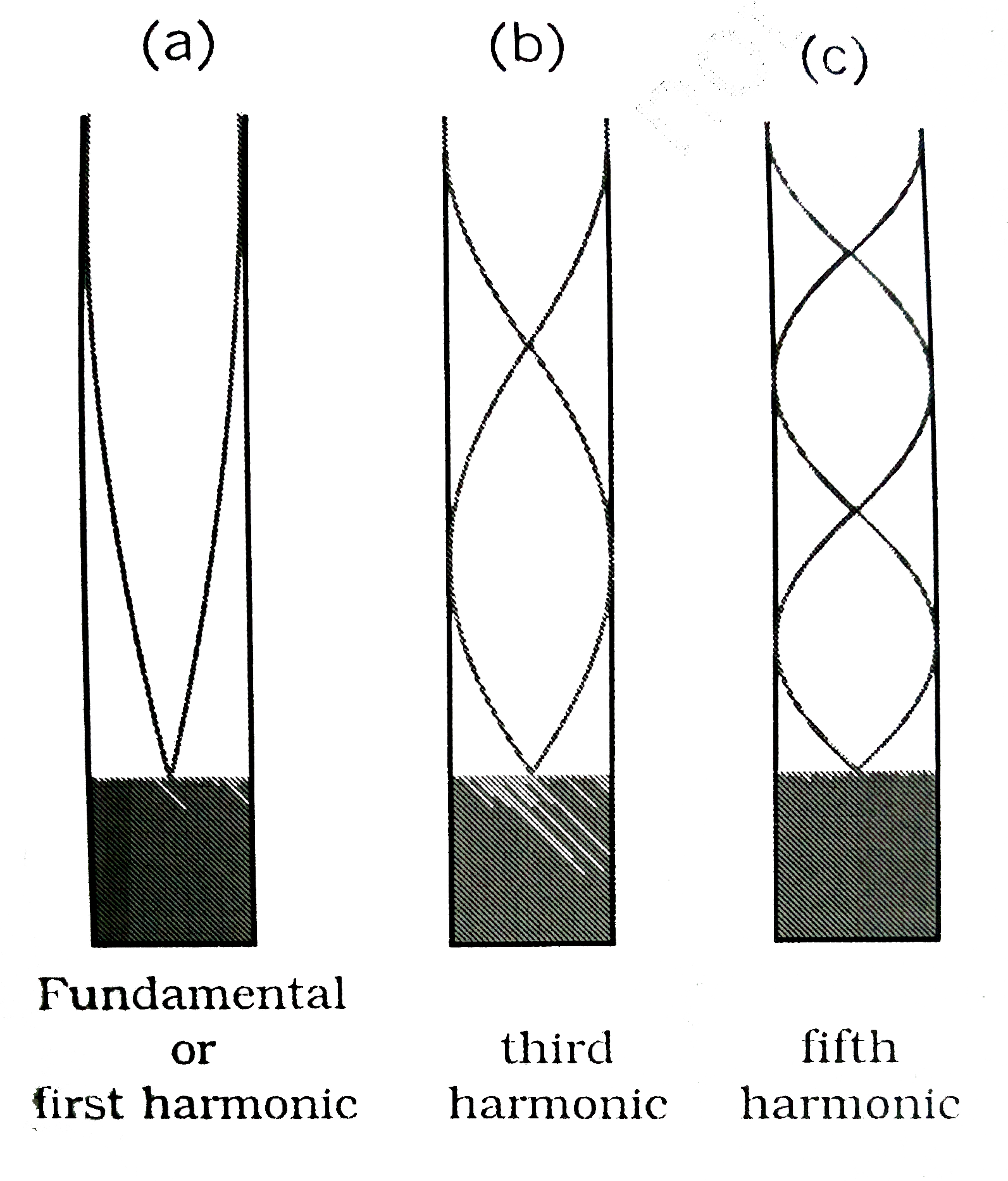
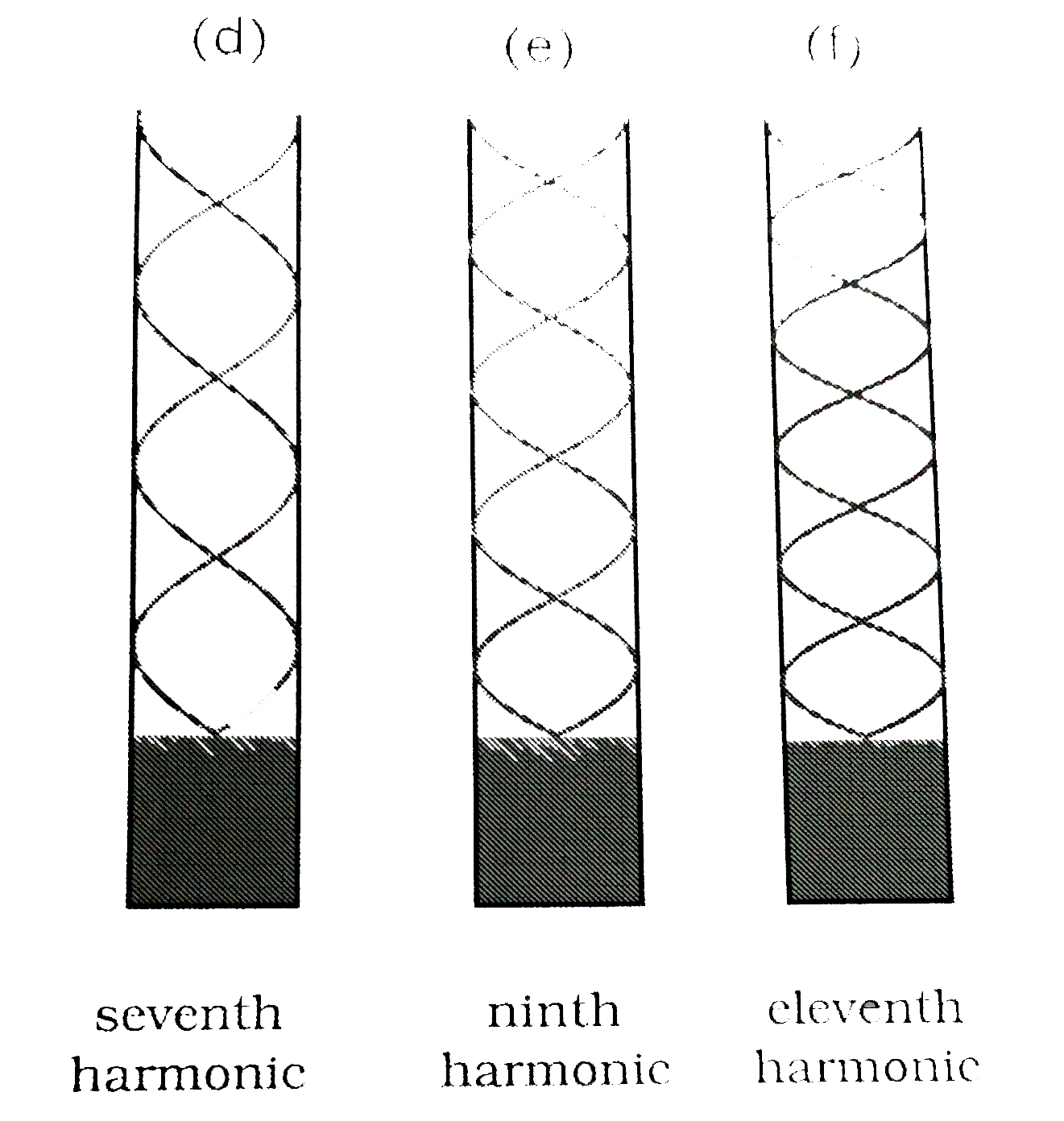
EXAMPLE 10
Two sitar strings A and B playing the note 'Dha' are slightly out of tune and produce beats of frequency 5 Hz. The tension of string B is slightly increased and the beat frequency is found to decrease to 3 Hz. What is the original frequency of B, if the frequency of A is 427 Hz?
Increase in the tension of a string increases its frequency. If the original frequency of B ( ν B) were greater than that of A(νA), further increase in νB should have resulted in an increase in the beat frequency. But the beat frequency is found to decrease. This shows that νB<νA. Since νA–νB=5Hz, and νA=427Hz, we get νB=422Hz
EXAMPLE 11
A rocket is moving at a speed of 200ms−1 towards a stationary target. While moving, it emits a wave of frequency 1000 Hz. Some of the sound reaching the target gets reflected back to the racket as an echo. Calculate the frequency of sound as detected by the person at the position of target and frequency of echo as detected by the rocket . Given velocity of sound =330ms−1.
(1) The observer is at rest and the source is moving with a speed of 200 m s−1. Since this is comparable with the velocity of sound, 330 m s−1, we must use Eq. (15.50) and not the approximate Eq. (15.51). Since the source is approaching a stationary target, vo=0, and vs must be replaced by –vs. Thus, we have
v=v0(1−vsv)−1
v=1000Hz×[1−200ms−1/300ms−1]−1
≅2540Hz
(2) The target is now the source (because it is the source of echo) and the rocket’s detector is now the detector or observer (because it detects echo). Thus, vs=0 and vo has a positive value. The frequency of the sound emitted by the source (the target) is v, the frequency intercepted by the target and not vo. Therefore, the frequency as registered by the rocket is
v'=v(v+v0v)
=2540Hz×(200ms−1+330ms−1330ms−1)
≅4080Hz
SUMMARY
* Mechanical waves can exist in material media and are governed by Newton’s Laws.
* Transverse waves are waves in which the particles of the medium oscillate perpendicular to the direction of wave propagation.
* Longitudinal waves are waves in which the particles of the medium oscillate along the direction of wave propagation.
* Progressive wave is a wave that moves from one point of medium to another.
* The displacement in a sinusoidal wave propagating in the positive x direction is given by y=Asin(kx−ωt+ϕ) where A is the amplitude of the wave, k is the angular wave number, ω is the angular frequency, (kx–ωt+ϕ) is the phase, and ϕ is the phase constant or phase angle.
* Wavelength λ of a progressive wave is the distance between two consecutive points of the same phase at a given time. In a stationary wave, it is twice the distance between two consecutive nodes or antinodes.
* Period T of oscillation of a wave is defined as the time any element of the medium takes to move through one complete oscillation. It is related to the angular frequency ω through the relation T=2πω.
* Frequency f of a wave is defined as 1T and is related to angular frequency by
f=ω2π.
* Speed of a progressive wave is given by
v=ωk=λT=λf.
* The speed of a transverse wave on a stretched string is set by the properties of the string. The speed on a string with tension T and linear mass density μ is
v=√Tμ.
* A travelling wave, at a rigid boundary or a closed end, is reflected with a phase reversal but the reflection at an open boundary takes place without any phase change.
For an incident wave
y=Asin(kx−ωt)
the reflected wave at a rigid boundary is
y=−Asin(kx+ωt)
For reflection at an open boundary
y=Asin(kx+ωt)
* The interference of two identical waves moving in opposite directions produces standing waves. For a string with fixed ends, the standing wave is given by
y=2Asinkxcosωt.
* The speed of a transverse wave on a stretched string is set by the properties of the string. The speed on a string with tension T and linear mass density μ is
v=√Tμ
* Sound waves are longitudinal mechanical waves that can travel through solids, liquids, or gases. The speed v of sound wave in a fluid having bulk modulus B and density ρ is
v=√Bρ
* The Doppler effect is a change in the observed frequency of a wave when the source (S) or the observer (O) or both move(s) relative to the medium. For sound the observed frequency ν is given in terms of the source frequency ν0 by
ν=ν0(v+v0v+vs).